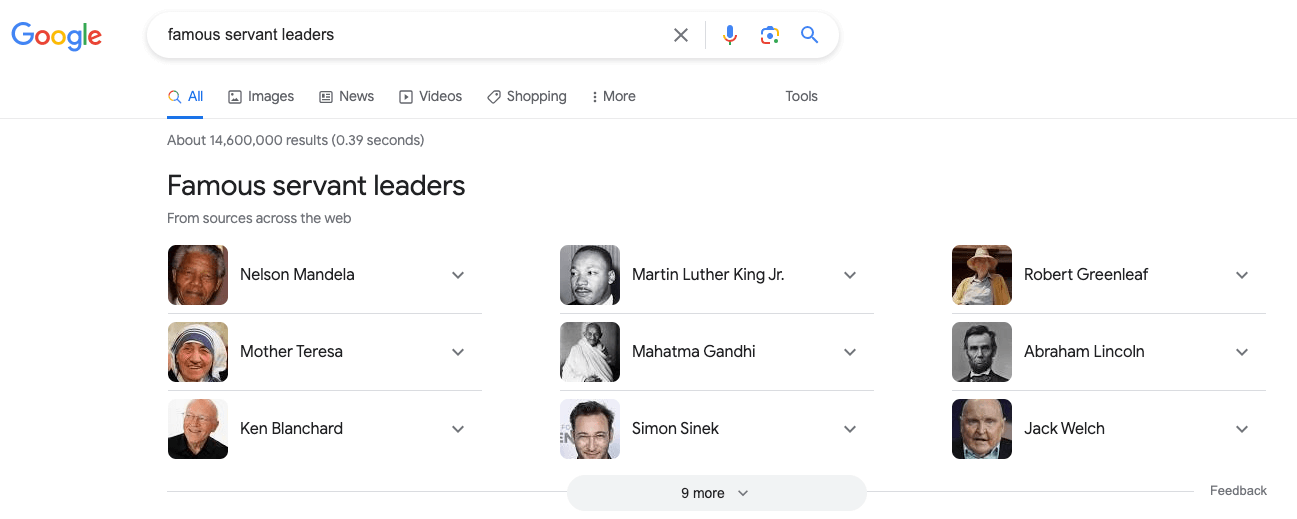10 Principles of Servant Leadership – Become a Servant Leader
There are several leadership styles and no one is superior to each other. However, servant leadership is the desired leadership style in many cases. In this article, we’ve defined what servant leadership style is, servant leadership principles, how to become a servant leader, and some famous servant leader examples.
In this article
📌 Hint: Do not skip this article, you will find FREE Leadership Training resources throughout the article.
What is Servant Leadership?
First, Robert K. Greenleaf coined the phrase “servant leadership” in his 1970 essay, “The Servant as a Leader.” However, it’s an approach that people have used for centuries for defining leadership.
As a servant leader, you’re a “servant first” – before thinking of yourself, you focus on the needs of others, especially team members. You are aware of other people’s self-interests, give them the assistance they need to meet their business and personal goals, include them in decisions where appropriate, and build a sense of community within your team. This results in higher engagement, more integrity, and better relationships with team members and other stakeholders. It can also lead to increased innovation.
In that essay, Greenleaf said:
“The difference manifests itself in the care taken by the servant-first to make sure that other people’s highest priority needs are being served. The best test, and difficult to administer, is: Do those served grow as persons? Do they, while being served, become healthier, wiser, freer, more autonomous, and more likely to become servants? And, what is the effect on the least privileged in society? Will they benefit or at least not be further deprived?”
Watch the Servant Leader YouTube Video
We have a 10-minute Servant Leadership video on YouTube. You can watch it to learn more about Servant Leadership.

💡 Read 15 Types of Leadership article to learn about other leadership styles.
Servant Leadership Style
A “servant leader ” is anyone, who can be an individual in the team, or a high-level executive, who leads simply by achieving the needs of the team. The term sometimes describes a person without formal recognition as a leader.
Servant leaders people often lead by example. They have high integrity, trust, and authenticity and they lead with generosity. A servant leadership approach can foster a positive corporate culture, and it can create high morale among the team.
Enhance Your Servant Leadership Skills – Executive Leadership Training Program
San Francisco Business School offers an online, self-paced comprehensive executive leadership training program. You can consider enrolling in this program to improve your leadership skills.
Supporters of the servant leadership model suggest that it’s a good way to move ahead in a world where values are increasingly important, and where servant leaders can achieve power because of their values, ideals, and ethics.
Servant leadership is not a leadership style or tool as such. Rather it’s a way of attitude and behaviour that you adopt and practice over the longer term. Servant leadership style completes democratic leadership styles, and it has familiarity with Transformational Leadership – which is often the most effective leadership style to use in business situations.
Servant Leader Example – John
Everyone on John’s team knows that he is ready to support “there for them.” He wanders around them often to see how they are, and he helps them improve the skills they need to enhance their careers, even if this means that they may move on to another company or organization.
John can think like he is in the other side’s shoes and looks at the cases from different perspectives. While he knows the self-interest of every individual on the team, he is trying to make decisions that every team member will have the maximum benefit.
So, John’s team is happy, motivated, and eager to work. His team has the lowest turnover ratio in the organization. John is an example of a “servant leader.”
Watch Laura’s 30 Seconds Experience – Executive Leadership Program
Hear from Our Alumni Laura Smith, Head of Design. Laura attended the Executive Leadership Program at SFBS.

10 Principles of Servant Leadership – Become a Servant Leader
There are several leadership skills that leaders have to show to their team. We’ve listed the top leadership skills in the 21 Leadership Skills Professionals Expect to See in the Workplace article. Larry C. Spears, former president of the Robert K. Greenleaf Center for Servant Leadership, proposes that the following 10 principles are crucial for servant leadership:
- Active-Listening.
- Empathy.
- Healing.
- Awareness.
- Persuasiveness.
- Conceptualization.
- Foresight.
- Stewardship.
- Commitment to the growth of people.
- Team Building
If you are aiming to be a servant leader, you need to develop these skills and practice them in your workplace over the long term.
Servant Leadership Principle #1 – Active Listening
People love being listened to. Many managers or executives do not give enough time to listen to their team members. However, if you do not listen to your members, you cannot understand their feelings. Therefore, active listening is at the top of the servant leadership principles.
You can help and support people better if you commit yourself to understanding what they are saying. There are several ways to improve your active listening skills. Some of the most popular are:
- Give your full attention: While you are talking with people, do not focus on other things. For instance, while your team members are talking, do not focus on your mobile phone or PC to check your emails or other work stuff. Try to maximize your eye contact.
- Watch out for body language: Reading body language requires different skills. Sometimes, a gesture, a hand, or a shoulder move may mean something when you are talking with other parties. You can attend courses to increase your body language skills.
- Do not interrupt: Wait for the other party to finish their sentences. Do not interrupt them until they complete their speech.
- Give feedback: Once they complete their speech, give feedback and show that you understood what they told even if you do not agree.
Free Online Leadership Skills Training Program
One of the requirements to be a good leader is to improve yourself continuously. The best way to do this is, to enhance your competence through training. Take a step ahead and jumpstart your leadership competence. Enroll in our 1-hour Free Leadership Training program.
Servant Leadership Principle #2 – Empathy
The dictionary meaning of empathy is the ability to understand and share the feelings of another. Servant leaders are experts in ignoring their own emotions or views when they are approaching the cases. They favor the values, views, and emotions of others and in the end, they try to make a decision for the best of the entire team.
Servant Leadership Principle #3 – Healing
Professionals look for supporting leaders. Servant leaders must help their team both physically and mentally. Start with completing the physical needs of your team first.
Physical needs can be workplace equipment, training, mentoring, or coaching. You can talk with them frequently to assess if they have any new requirements to perform better.
Second, try to focus on mental health. For sure, happy team members perform much better. You can wander around frequently and do small private talks with the members to check how they feel at the workplace. If there is anything you can help them with, do not refrain from doing your best.
4. Self-Awareness
In short, self-awareness is knowing yourself. What are your strengths, and what are your weaknesses, are you calm, or are you quick-tempered? Several personal traits affect the leadership style of leaders.
Servant leaders are aware of themselves and their emotions and moods. They know how it can affect people so they try to suppress their bad feelings or emotions when they are with their team.
You can become more self-aware by knowing your strengths and weaknesses and asking for other people’s feedback on them.
5. Persuasiveness
Professionals look for charisma, persuasion, and influence in their leaders. Charisma is described as a personal quality of presence or charm that others find compelling.
Charismatic leaders combine charm, interpersonal connection, and persuasiveness to motivate others. Professionals seek charisma, persuasion, and influence leadership skills in their executives. These skills will help their business unit to overcome obstacles, communicate with other departments in the organization easily, and have a better performance in the end.
Servant leadership requires using persuasion – rather than hierarchical power – to motivate people to perform. Servant leaders seek consensus rather than compromise in group discussions. Otherwise, some members might not be happy with the decision.
Many courses, programs, or tools can help you improve your persuasion skills without hampering the other’s interests. Building an expert power is one of the best ways to increase your persuasiveness. Once people see you as an expert, they will be more likely to listen and follow you.
6. Conceptualization
This principle is all about being able to see the big picture. Organizations have strategies, missions, and visions. These are ensured through projects, tasks, and activities performed by individuals. Conceptualization is seeing the big picture, and conveying this to the team members through how their tasks or self-interests are linked to the organization’s strategy, mission, and vision.
Servant leaders are excellent at turning organizations’ goals into actionable items for the team members.
7. Foresight
Servant leaders should be like chess masters. They should be able to predict the future, analyze the current conditions, and make the best move next for the best interest of their team.
There are several tools for effective decision-making. Servant leadership requires using tools such as SWOT analysis, PESTEL analysis, Scenario Analysis, etc.
If you are an experienced leader, your intuition can tell you the best steps as well. Trust your intuition as well when making decisions.
8. Stewardship – Taking Responsibility
Stewardship is about taking responsibility.
Leaders or managers are responsible for their teams. So, when there is a success, it accounts for the entire team. However, if there is a failure, people may start to look for a scapegoat. Leaders play a vital role here. They should prevent their team, and absorb the pressure coming from higher management. Leaders should take responsibility for their team.
9. Commitment to the Growth of People
We’ve mentioned at the beginning of the article that, servant leadership is all about thinking about your people and growing them. Therefore, commitment to the growth of the team members is one of the characteristics of servant leaders even if the people in your team may move on to other organizations.
Skilled resources perform better for sure. Servant leaders make sure that their teams get the best tools and training to perform their activities. The world is changing, so the needs of the team may change frequently. Servant leadership is required to assess the training needs of the team and plan activities to grow the competence of the team.
10. Team Building
Team building is growing strong teams that have strong professional bonds and perform efficiently to provide better outputs. Tuckman identifies team building in five stages:
- Forming: The team is gathering at this stage. The team is structured, and no one knows each other enough.
- Storming: The team starts to perform and interpersonal conflicts start to arise.
- Norming: In this stage, team members are creating new ways of doing and being together. Team members start to trust each other.
- Performing: The most productive stage of the team. Everyone knows each other, and support is at the highest degree.
- Adjourning: The work is finished, and the team adjourns.
The critical moments in teams are when a new one joins the team, or if the whole team is formed recently. Servant leader’s team-building skills will play a significant role in minimizing conflicts and reaching the maximum performance level.
You can plan parties, activities, or non-work-related meetings to increase bonds within your team.
Flaws of Servant Leadership
While there are several benefits of servant leadership, nothing comes without a flaw.
Some people believe that servant leadership may leave them behind by other leaders especially when there is competition. Servant leadership is all about thinking about the interests of the team rather than your self-interests. In competitive environments, this can give an advantage to your counterparts because you are not thinking of your self-interests.
Servant leadership might be time-consuming in case you need to make quick decisions. Servant leaders seek consensus. To do this, you need to go through each opinion and listen to each member of your team before you come to a conclusion. However, if you are working under tight deadlines, this might not be possible.
Servant leadership might not be suitable for traditional, hierarchical, or autocratic organizations. Because managers or leaders make all the decisions in these types of organizations. For instance, in the army or government, it is not easy to apply servant leadership. Read more on our Autocratic Leadership article.
Famous Servant Leaders
When we searched for the “famous servant leaders” in Google, we saw the following leaders in the top nine results.


We should not be surprised to see Robert Greenleaf, the father of the Servant Leadership concept. We picked three servant leaders and explained their servant-leader characteristics below.
Servant Leader #1 – Nelson Mandela
Nelson Rolihlahla Mandela (18 July 1918 – 5 December 2013) was a South African anti-apartheid activist and politician who served as the first president of South Africa from 1994 to 1999. He was the country’s first black head of state and the first elected in a fully representative democratic election.
Mandela fought for equality and democracy in his country. While he was trying to serve his people, he was against the powerful colonizers and he had to put his life and interests at risk while fighting for his people. Mandela says: “It is better to lead from behind and to put others in front, especially when you celebrate victory when nice things occur. You take the front line when there is danger. Then people will appreciate your leadership.”
You can read more about Nelson Mandela leadership style.
Servant Leader #2 – Jack Welch, Former CEO of General Electric
Jack Welch is an iconic leader of General Electric. He started his career in General Electric in 1960, as a junior chemical engineer and became the CEO from 1981 until 2001.
Jack Welch’s famous servant leadership saying is “Before you are a leader, success is all about growing yourself. When you become a leader, success is all about growing others.” His servant leadership transformed General Electric from a bulb manufacturer into a multinational corporation.
You can read more about Jack Welch leadership style.
Servant Leader #3 – Ken Blanchard
Kenneth Hartley Blanchard (born May 6, 1939), known as Ken Blanchard, is an American author, business consultant, and motivational speaker who has written over 60 books, most of which were co-authored. His most successful book, The One Minute Manager, has sold over 15 million copies and has been translated into many languages.
Ken’s famous saying about servant leadership is: “In the past, a leader was a boss. Today’s leaders must be partners with their people… they no longer can lead solely based on positional power.”
There are several famous examples of servant leadership. You can read their stories, be inspired by their leadership wisdom, and apply them in your workplace.
Summary
Servant leadership is thinking about the team and individuals in the team rather than your self-interests. Servant leaders help their team members at all costs and their ultimate goal is to grow their team even if they choose to move on to the competitors or other organizations.
There are several characteristics of servant leaders. We have gone through the top 10 characteristics of servant leaders: active listening, empathy, healing, awareness, persuasiveness, conceptualization, foresight, stewardship, commitment to the growth of people, and team building.
Although servant leadership is very popular, there are some flaws in the theory. When quick decisions are needed, seeking consensus among the team may not be feasible. Also, some people argue that putting others’ interests in front of yours characteristic of servant leadership may cause leaders to be left behind in competitive environments. And, applying servant leadership may not be suitable in some cases, such as autocratic or hierarchical cultures.

